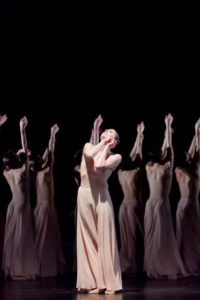Paris: Summer 2018 - Vancouver Ballet Society
- Home
- City Reports 2015 - 2019
- Paris: Summer 2018

By François Fargue
John Cranko’s 1967 Onegin, presented by Paris Opera Ballet at the Garnier in March, is one of the most romantic yet intriguing ballets. Based on the eponymous verse novel by Russian writer Pushkin, the story goes that the young yet world-weary and cynical rich Onegin rejects the love of naïve Tatiana, whom he has only encountered briefly. He tries to steal his friend Lensky’s girlfriend, Olga, who happens to be Tatiana’s sister. Lensky disapproves, they fight a duel and Lensky gets killed. Olga then disappears and so does Onegin. Decades later, Tatiana has married on the rebound and is a rich but bored wife. Onegin reappears at a ball Tatiana attends and falls madly in love with her. But she, an honourable spouse, rejects him.
Now here’s a love story that takes some suspension of disbelief. That Onegin should fall madly in love with Tatiana — to the point of stretching into the longest and saddest of arabesques — just when she is no longer free is hard to believe. But then the right dancers can make us fall for such an illusion.
Étoile Mathieu Ganio’s admirable lines allowed him to portray Onegin’s weary distinction to a T. His high arabesques and tornado pirouettes also helped convey the character’s passion. However, he lacked some of the incisiveness shown, say, by guest artist Evan McKie (who danced the role opposite Aurélie Dupont in 2014).
As Tatiana, étoile Ludmila Pagliero’s lines and technique were no less admirable, but she, right from the start, somehow looks too experienced not to know better than to fall for such a cad. However beautiful to look at, this couple did not quite succeed in making one forget the absurdity of the story.
The winning supporting couple of the same cast was by far petite étoile Myriam Ould-Braham, a scintillating coquette in the role of Olga, and Mathias Heymann as her fiancé, Lensky. Heymann has one the most exciting techniques in the company and poured himself passionately into the role, which is arguably more coherent than that of Onegin.
For all the caveats, Cranko’s ballet is successfully atmospheric, superb choreographically speaking and follows a clearly delineated narrative. An undeniable treat.
Before his brief stint as Paris Opera Ballet director, Benjamin Millepied had been invited twice to choreograph for the company. Later, in 2014, as a budding director, he choreographed Daphnis et Chloé to Maurice Ravel’s score and, opportunistically enough — and costly, too, one may imagine — with a set by artist Daniel Buren, who is famous in France for his controversial signature black-and-white striped columns at Le Palais Royal gardens in Paris. The motif is to be found in the ballet, too, enhanced by bright colours.
Millepied has been known to favour geometrical shapes for his ballets that are in contrast with his fluid but as yet not identifiable style. Ignoring the buzz created by Buren, Daphnis et Chloé was deemed at the time rather long and conventional. There was indeed little need for the reprise this season. It is neither a sure-fire treat for the audience nor substantial meat for the dancers. Only François Alu provided the apex of the evening as Briaxis, chief of the men who abduct Chloé. Young premier danseur Alu does not have the lines of a danseur noble, but amply makes up for that with thrilling technique and heaps of charisma. The audience loves him. But for all the excitement he brings, he still hasn’t been made an étoile.
Béjart’s Bolero followed, as the second and last piece of a rather meagre program. The piece, one of his enduring hits, was created in 1961, featuring a lone woman dancer — Serbian Duska Sifnios — surrounded by an ensemble of men.
Here, the central role was performed by Marie-Agnès Gillot, one of the most publicized and larger than life étoiles at the Paris Opera, who had danced the role in the past. Being a tall woman with long arms, she once again cut an impressive figure from the word go. Her performance was striking, but she has lost some of the required stamina.
Shortly after, at the end of March, Gillot, at age 42, retired, performing in Pina Bausch’s Orpheus and Eurydice. An infallible ballet technician, her athletic body is well suited to this kind of contemporary repertoire. In her speech at the party following the show, she admitted to not having been the easiest person to handle. But then her greatness also lies in her rich and raw spontaneity, which indeed characterized her numerous curtain calls that night as her five-year-old son and their small dog cavorted onstage with her. It was a great evening for one of the last of the Paris Opera’s true stars.

Photo: Agathe Poupeney
